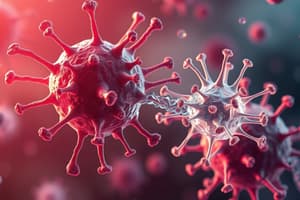Podcast
Questions and Answers
What are the common environments where microbes can be found?
What are the common environments where microbes can be found?
- Only in soil and water
- Only in the human body
- In extreme environments and on living organisms (correct)
- Only within living organisms
Which term refers to the collective community of microorganisms in and on our body?
Which term refers to the collective community of microorganisms in and on our body?
- Pathobiome
- Microbiome (correct)
- Promicrobia
- Microflora
Which statement best describes opportunistic pathogens?
Which statement best describes opportunistic pathogens?
- Become harmful when growth increases or is in the wrong spot (correct)
- Only exist in healthy hosts
- Are non-pathogenic unless in extreme conditions
- Always cause harm regardless of location
How does the number of microbial cells in the human body compare to human cells?
How does the number of microbial cells in the human body compare to human cells?
Which of the following is an example of a well-known virulent strain of Pseudomonas aeruginosa?
Which of the following is an example of a well-known virulent strain of Pseudomonas aeruginosa?
In the context of microbiota, which area is NOT typically associated with normal flora?
In the context of microbiota, which area is NOT typically associated with normal flora?
What role do microorganisms play in ecosystems?
What role do microorganisms play in ecosystems?
Which statement is true regarding microbial interactions and health?
Which statement is true regarding microbial interactions and health?
What process is described as the internalization of a prokaryotic cell by ancient Archaea to form organelles?
What process is described as the internalization of a prokaryotic cell by ancient Archaea to form organelles?
Which organelles are formed as a result of endosymbiosis?
Which organelles are formed as a result of endosymbiosis?
What classification system is used to name species, including their genus and species names?
What classification system is used to name species, including their genus and species names?
What defines a type strain within a species?
What defines a type strain within a species?
What do ribosomal RNA genes help classify in the context of the universal tree of life?
What do ribosomal RNA genes help classify in the context of the universal tree of life?
Which of the following eukaryotes typically contains chloroplasts?
Which of the following eukaryotes typically contains chloroplasts?
Which statement about prokaryotes and eukaryotes is true?
Which statement about prokaryotes and eukaryotes is true?
What essential function do mitochondria serve in eukaryotic cells?
What essential function do mitochondria serve in eukaryotic cells?
What is the primary purpose of a Gram stain in microbiology?
What is the primary purpose of a Gram stain in microbiology?
What color do Gram positive bacteria appear after a Gram stain procedure?
What color do Gram positive bacteria appear after a Gram stain procedure?
What role does iodine play in the Gram staining process?
What role does iodine play in the Gram staining process?
Which statement about bacterial growth is true?
Which statement about bacterial growth is true?
Which type of microscopy would benefit most from using a selective stain?
Which type of microscopy would benefit most from using a selective stain?
What characteristic of bacterial growth allows them to replicate more quickly than eukaryotes?
What characteristic of bacterial growth allows them to replicate more quickly than eukaryotes?
Who perfected the Gram staining method?
Who perfected the Gram staining method?
What is the result of the Gram stain for Gram negative bacteria?
What is the result of the Gram stain for Gram negative bacteria?
What is a mode of transmission for Yersinia pestis?
What is a mode of transmission for Yersinia pestis?
In urban areas, how does Yersinia pestis typically spread?
In urban areas, how does Yersinia pestis typically spread?
Which of the following best describes the sylvatic mode of transmission?
Which of the following best describes the sylvatic mode of transmission?
Which statement about the key components of bacterial cells is accurate?
Which statement about the key components of bacterial cells is accurate?
What effect does the environment have on microbial growth?
What effect does the environment have on microbial growth?
Which of the following choices describes a unique characteristic of prokaryotic cells?
Which of the following choices describes a unique characteristic of prokaryotic cells?
What structural component relates to the gram stain of a bacterial cell?
What structural component relates to the gram stain of a bacterial cell?
Which habitat is least likely to support microbial growth?
Which habitat is least likely to support microbial growth?
How does human-to-human transmission of Yersinia pestis occur?
How does human-to-human transmission of Yersinia pestis occur?
What is a key component distinguishing eukaryotic cells from prokaryotic cells?
What is a key component distinguishing eukaryotic cells from prokaryotic cells?
What is a characteristic of aerosol transmission?
What is a characteristic of aerosol transmission?
Which of the following is NOT a source of droplet transmission?
Which of the following is NOT a source of droplet transmission?
What is the difference between direct and indirect contact transmission?
What is the difference between direct and indirect contact transmission?
Which mode of transmission involves arthropods?
Which mode of transmission involves arthropods?
Which size range describes droplet transmission?
Which size range describes droplet transmission?
What can enhance the survival of microorganisms in the air?
What can enhance the survival of microorganisms in the air?
Which of the following is an example of indirect contact transmission?
Which of the following is an example of indirect contact transmission?
What does vector-borne transmission require for effective pathogen spread?
What does vector-borne transmission require for effective pathogen spread?
What is a common characteristic of contact transmission?
What is a common characteristic of contact transmission?
Which of the following diseases is transmitted via arthropod vectors?
Which of the following diseases is transmitted via arthropod vectors?
Flashcards are hidden until you start studying
Study Notes
Cell Structure and Function
- Eukaryotic cells contain organelles like nuclei, mitochondria, and chloroplasts (in plants).
- Chloroplasts are found in photosynthetic eukaryotes such as plants and algae.
- Prokaryotes contributed to the evolution of eukaryotes through endosymbiosis, where a prokaryotic cell is internalized by an ancient Archaea.
Evolutionary Classification
- Cells are classified under three domains based on ribosomal RNA genes, forming a universal tree of life.
- Binomial classification employs genus and species names for identifying organisms, e.g., Pseudomonas aeruginosa.
Microbial Ecology
- Microbes are widespread in various environments, including soil, water, and extreme conditions.
- Human microbiome consists of normal flora, essential for health, present in areas like the gastrointestinal tract and respiratory system.
- Microbiome interactions are crucial for health professionals as there are more microbial cells in the human body than human cells.
Bacterial Identification Techniques
- Gram Staining: The primary method for identifying bacterial types based on cell wall composition.
- Gram-positive bacteria stain purple, while gram-negative bacteria stain pink.
- Iodine acts as a mordant, forming a complex with crystal violet in the staining process.
Bacterial Growth Characteristics
- Prokaryotes replicate rapidly through binary fission, more efficient than eukaryotic division methods.
- Doubling times for bacteria vary, allowing for rapid population changes under suitable conditions.
- Bacterial survival depends on environmental factors such as temperature, humidity, and external protection (mucous).
Transmission Modes of Pathogens
- Aerosol Transmission: Pathogens in small droplets (>1 meter) via coughing or sneezing; difficult to contain with masks.
- Droplet Transmission: Larger droplets (<1 meter), more manageable with surgical masks.
- Contact Transmission: Involves direct contact (e.g., touching, sexual contact) or indirect contact via contaminated objects (fomites).
- Vector-Borne Transmission: Involves living organisms (usually insects) that carry pathogens, such as mosquitoes or fleas transmitting diseases like malaria and plague.
Vector-Borne Diseases
- Several diseases transmitted by vectors, including:
- Mosquitoes associated with Zika virus, Dengue fever, and more.
- Yersinia pestis (plague) transmission through flea vectors links urban and sylvatic (non-urban) mammal populations.
Learning Objectives
- Understand the three domains of life and binomial nomenclature.
- Compare the structural components of prokaryotic versus eukaryotic cells.
- Recognize bacterial cell structure and the significance of the bacterial cell wall in Gram staining.
- Comprehend environmental impacts on microbial growth and the habitats where microbes thrive.
- Learn about various modes of pathogen transmission and associated disease examples.
Studying That Suits You
Use AI to generate personalized quizzes and flashcards to suit your learning preferences.




